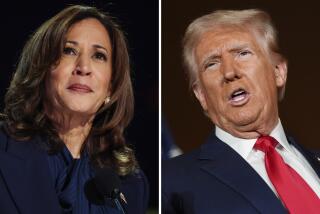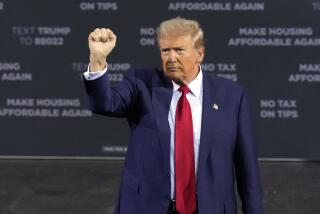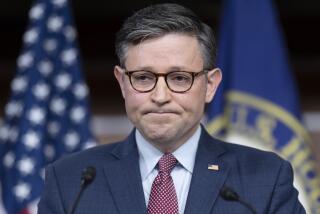Obama says budget reflects values with money for schools, job training
- Share via
WASHINGTON -- President Obama unveiled a budget proposal Tuesday that increases spending on early childhood education, job training, high-tech manufacturing and urban redevelopment in an effort to shrink the gap between rich and poor.
“Our budget is about choices. It’s about our values,” Obama said Tuesday as he promoted his spending plan at a local elementary school. “We’ve got to decide if we’re going to keep squeezing the middle class or reduce our deficits responsibly.”
The annual budget plan includes an additional $56 billion for what the White House dubs the “Opportunity, Growth the Security Initiative.” The list is a grab bag of Democratic priorities currently stalled in a divided Congress.
Obama’s budget is unlikely to shake them free. The blueprint, required by law and arriving weeks late, is not expected to become a road map for congressional appropriators. Congress recently approved a two-year budget deal after years of ugly budget fights and there is little interest in reopening the debate.
Still, Obama’s proposal offers insight into what this president -- unmoored from his own reelection concerns, the financial crisis and battles over the deficit – would do if he could break through the limits of Republicans opposition.
The plan shows Obama, even at his most aspirational, seeking a liberal but pragmatic agenda. Obama’s budget would largely build on existing tax benefits aimed at the working poor, rather than create new major tax breaks. He would expand education tax credits and double to $1,000 a tax credit available to low-income, childless workers.
He would add to federal spending on early childhood education -- reviving his promise to expand access to preschool -- and job training programs. He would encourage savings for retirement to workers without access to employer-sponsor saving accounts. And he would expand the urban revitalization effort known as “Promise Zones.”
The expanded initiatives would be offset by tobacco taxes and by closing loopholes used primarily by the wealthy. Obama’s budget also reduces spending on military programs.
Overall, Obama’s budget details $3.901 trillion in federal spending. The White House says the plan will reduce the government’s annual deficit to 1.6% of gross domestic product in 10 years and will begin shrinking the debt in 2016.
Of the annual budgets he has proposed, the fiscal year 2015 spending plan is the one least dictated by outside fiscal or political goals. Obama’s first years in office were marked by efforts to address the economic crisis. His last few budgets have been aimed at demonstrating his willingness to cut deficits and address the long-term debt.
This year’s plan includes marks a turn away from those aims. The White House announced in advance the plan would not include a proposal to cut back on the growth of entitlement benefits by changing how cost-of-living increases are calculated. That proposal had been a gesture of outreach to Republicans but was reviled by liberal Democrats.
This plan got a much warmer welcome from Obama’s allies on Capitol Hill, offering them a strong contrast between the president’s economic policies and their Republican rivals this election year.
In announcing his proposal at a Washington, D.C., elementary school, Obama said his budget is “not just about numbers, it’s about our values.”
“It’s a road map for creating jobs,” he said, that “allows us to meet our obligations to future generations without leaving them a mountain of debt.”
Rep. Peter Roskam (R-Ill.), a member of the House leadership, criticized Obama for dropping the proposal to change cost-of-living calculations, calling the spending plan a “disappointing, fantasy-based budget [that] proves he isn’t serious about finding common ground with Republicans.”
More to Read
Sign up for Essential California
The most important California stories and recommendations in your inbox every morning.
You may occasionally receive promotional content from the Los Angeles Times.











